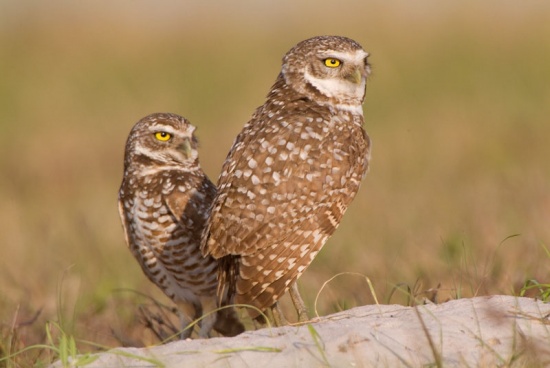| Line 1: | Line 1: | ||
| + | [[Image:Burrowing_Owl.jpg|thumb|550px|right|Photo by Juninho<br>Location: Fort Myers, [[Florida]], [[USA]] ]] | ||
| + | |||
;[[: Category:Athene|Athene]] cunicularia | ;[[: Category:Athene|Athene]] cunicularia | ||
| − | |||
==Identification== | ==Identification== | ||
| Line 20: | Line 21: | ||
==Habitat== | ==Habitat== | ||
Open areas, mostly with some trees or bushes. | Open areas, mostly with some trees or bushes. | ||
| − | == | + | ==Behaviour== |
Though mainly a nocturnal hunter, Burrowing Owls are fairly active during the daytime. In broad daylight, these diminutive hunters perch conspicuously in the open, whether on the ground next to the entrance hole or on a neaby post. Fairly bold, typically allows people fairly close, unless it has owlets in the nest. Like most birds, they are very protective of their young. | Though mainly a nocturnal hunter, Burrowing Owls are fairly active during the daytime. In broad daylight, these diminutive hunters perch conspicuously in the open, whether on the ground next to the entrance hole or on a neaby post. Fairly bold, typically allows people fairly close, unless it has owlets in the nest. Like most birds, they are very protective of their young. | ||
| − | Though they will excavate their own burrows, they will readily commandeer the (sometimes)abandoned nests of creatures such as ground squirrels, prairie dogs, armadillos, and gophers. | + | Though they will excavate their own burrows, they will readily commandeer the (sometimes) abandoned nests of creatures such as ground squirrels, prairie dogs, armadillos, and gophers. |
| − | + | ||
| − | Eats a range of prey, including crickets, grasshoppers, beetles, and small rodents. Places the dung of animals such as bison or cattle near its nest hole. The function of this was until recently unknown, but has been proven to attract beetles and other insects; a tasty snack. | + | Diet: Eats a range of prey, including crickets, grasshoppers, beetles, and small rodents. Places the dung of animals such as bison or cattle near its nest hole. The function of this was until recently unknown, but has been proven to attract beetles and other insects; a tasty snack. |
==External Links== | ==External Links== | ||
Revision as of 20:31, 13 January 2009
- Athene cunicularia
Identification
Small owl
Length 9 in, wingspan approximately 20-22 in
- Long legs
- Bright golden eyes
- Brown above
- White spotting and brown barring on the breast and belly
- Somewhat buffy below
- Prominent white eyebrow and throat
A strong flyer, often seen in low, undulating flight. Burrowing Owls are also adept at hovering, fluttering like an American Kestrel over their prey.
Distribution
Spottily over North, Central and South America.
Taxonomy
Thirteen to twenty-three subspecies are recognized for this species. In the past, Burrowing Owl was placed in genus Speotyto; it is now placed in genus Athene as the only "new world" representative.
Among the subspecies, Western hypugaea is slightly paler than floridiana in Florida. Florida birds are also more heavily spotted, with less buff underparts.
Habitat
Open areas, mostly with some trees or bushes.
Behaviour
Though mainly a nocturnal hunter, Burrowing Owls are fairly active during the daytime. In broad daylight, these diminutive hunters perch conspicuously in the open, whether on the ground next to the entrance hole or on a neaby post. Fairly bold, typically allows people fairly close, unless it has owlets in the nest. Like most birds, they are very protective of their young.
Though they will excavate their own burrows, they will readily commandeer the (sometimes) abandoned nests of creatures such as ground squirrels, prairie dogs, armadillos, and gophers.
Diet: Eats a range of prey, including crickets, grasshoppers, beetles, and small rodents. Places the dung of animals such as bison or cattle near its nest hole. The function of this was until recently unknown, but has been proven to attract beetles and other insects; a tasty snack.




